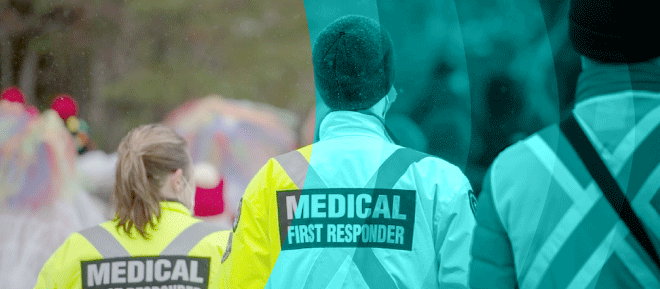
24 Oct Emergency medical service responders reflect on the pandemic: Interventions in Israel and Spain – Part II
How did EMS responders in different countries, positions, and life stages experience an unprecedented health crisis?
In June and July 2023, COVINFORM partners Magen David Adom (MDA: https://www.mdais.org/en) and S.A.M.U.R. Proteccion Civil (SAMUR: https://www.madrid.es/samur) conducted participatory interventions to explore this question. Specifically, the partners organised workshops with 60 paid staff and volunteers in Tel Aviv and Madrid, with the objective of validating the COVINFORM research findings and giving responders a sense of participation and ownership in the project. The workshops were split between volunteers (N=32 total) and paid staff (N=28), as well as between those under 30 years old (N=34) and those over 40 (N=26). They provided an opportunity to experiment with innovative participatory methods, as well as yielding insight on responders’ own well-being and assessment of vaccination campaigns. A prior COVINFORM blog post focuses on the former topic, while this entry focuses on the latter – as well as offering some recommendations for future public health crises.
Vaccination and risk communication campaigns require audience testing and better attention to vulnerable groups
EMS responders’ presence at the front line of the pandemic gave them particular insight into the strengths and weaknesses of vaccination campaigns. They underlined the importance of careful health and risk communication planning: if communication campaigns are not validated, comprehensive, well-structured, and easily understandable, they can undermine community participation. Some responders observed that many healthcare organisations lack communications professionals at the mid- and upper-management levels, leading to competence gaps.
Workshop participants in both countries emphasised that risk communicators should evaluate audiences’ receptions of their campaigns (e.g., via pre- and post-testing), rather than simply assuming everything went as planned. They noted that a global health event such as COVID-19 offers a unique opportunity to systematically assess the scope, successes, and failures of existing communications strategies in order to derive lessons for the future.
A number of responders under 30 in both countries paid special attention to vulnerable groups such as the houseless, migrants, elderly people, and people with mobility issues. In Spain, responders noted a lack of personnel and resources needed to reach such groups; this was complicated by the endemic weakness of primary care networks, and sometimes low community engagement. In Israel, digital divides were implicated as barriers, especially as vaccination bookings were conducted primarily online. Younger responders in both countries warned that the pandemic appeared to have lent momentum to anti-vaccination movements. Older respondents not only concurred, but added that the oversaturation of information provided fertile breeding ground for mis- and disinformation, making it difficult for the public to find reliable guidance when they needed it.
EMS responders are underappreciated and under-resourced as a source of data, lived wisdom, and informational support
The MDA and SAMUR workshops served to underscore two COVINFORM project priorities: giving a voice to health care workers and strengthening the cooperation between practitioners and researchers. More than simply validating the project findings, the workshops yielded novel data. They revealed that despite very different social contexts, EMS responders in both Israel and Spain experienced similar stresses and observed similar gaps in public health policies and systems. By contrast, the workshops also shed light on differences between the well-being priorities of older and younger EMS responders.
For public health administrators and policymakers alike, these participatory interventions offer valuable guidance. EMS responders in both countries were frank in attributing their increase in workload to sub-optimal resource management on the part of health institutions on the one hand, and inadequate governmental support on the other. The lack of formal psychological support was a particularly serious concern. One source of isolation and confusion was “applause dissonance”: the coeval experience of public acclaim and stigma or even physical confrontation (due to perceived risk of exposure). Combined with the fear of exposure, such complex experiences put strain on responders’ relationships with their families, thus worsening their sense of isolation.
The workshop also made it clear that EMS responders were underappreciated as a source of data – or better, lived wisdom – during the pandemic. Responders’ front-line work brings them face to face with how patients live through health crises and how public health policies and system characteristics impact their lives. This contrasts with the top-down perspectives of policymakers or virologists – which inevitably shape their decisions. Consulting with responders could improve policymakers’ understanding of how public health measures impact diverse aspects of life such as housing, economic situations, family situations, and community dynamics.
Finally, both the workshop participants and the organisers noted that EMS responders were under-utilised and under-resourced as a communications channel. Governmental evaluations stress the need to leverage “multipliers” – trusted intermediaries – while disseminating health and risk information to vulnerable groups. However, they seldom provide detail as to who might play this role, or how. During the pandemic, EMS responders were in frequent close contact with vulnerable individuals and groups. Due to their affiliations and the critical services they provided, they also enjoyed high levels of trust. This placed them in an ideal position to disseminate information on regulations and health-protective measures, including vaccination. However, they did not often have access to appropriate informational resources. Providing EMS responders and other front-line practitioners with target-group-specific communication materials – ideally pre-tested for audience reception – could significantly increase the impact of risk communication campaigns.
Author: Dr. James Edwards, SINUS-Institute
